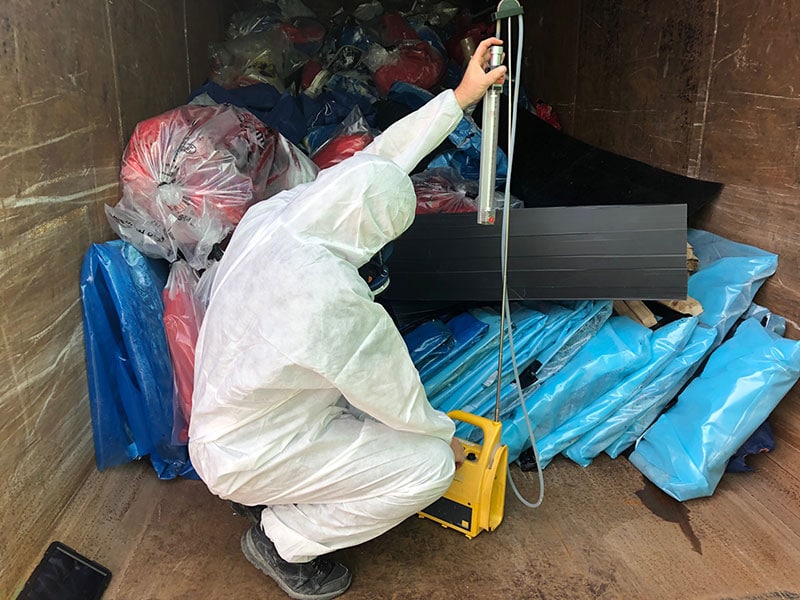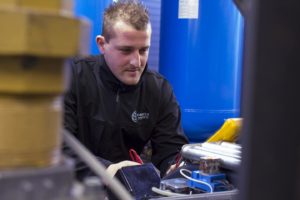A Complete Guide to Asbestos Air Testing
Although there is a range of asbestos air testing names, they all have the same method and approach in testing for airborne asbestos fibre levels. Each asbestos air test has the same outcome in mind and is designed to give detailed data showing asbestos fibre concentrations in a particular place and time.

Why do asbestos air tests have different names?
Asbestos air testing goes under different names. When they are procured, the asbestos air testing company understands what the customer needs from the requested asbestos air test. This means that the air testing company can ensure they have the correct amount of equipment and allow the correct amount of time to deliver the asbestos air testing and air testing results as required by the customer.
What are the different names of asbestos air tests and air testing?
There are five main named asbestos air testing strategies:
- Asbestos REASSURANCE Air Testing & Monitoring
- Asbestos BACKGROUND Air Testing & Monitoring
- Asbestos LEAKAGE Air Testing & Monitoring
- Asbestos CLEARANCE Air Testing & Monitoring
- Asbestos PERSONAL Air Testing & Monitoring
Each of these air testing strategies has a particular desired outcome. Customers will use one or more of these air testing strategies for their needs dependent upon the situation or project.
What is Asbestos Reassurance Air Testing and Monitoring?
Asbestos reassurance air testing is used when there is a need to confirm that an asbestos-related task or disturbance has not resulted in asbestos airborne fibre concentrations above the current asbestos respirable fibre control limit.
Reassurance air testing is often used when people are concerned that asbestos has been disturbed and there may be a risk of asbestos exposure. This is an unplanned asbestos disturbance. The air testing confirms the amount of asbestos fibre that is airborne and provides details on the likelihood of any asbestos exposure to those that have been or will be near the affected area.
In addition, reassurance air monitoring can be used after planned asbestos works. The asbestos air test can reassure that the works have been undertaken safely and that all control measures have been adequate. Reassurance air testing post planned asbestos works provide details on the likelihood of any asbestos exposure to those that have been or will be near the affected area. It is also typically used during the four-stage clearance process, which is legally required after asbestos removal and remediation projects within an enclosed asbestos work area.
What is Asbestos Background Air Testing and Monitoring?
Asbestos background air testing is used when you want to monitor the asbestos in air quantity during a task that has the potential to disturb asbestos. It is generally during asbestos remediation or asbestos removal works. The air testing is carried out in the background when the asbestos task is being carried out.
The background asbestos air test is designed to monitor airborne asbestos fibres during the works in question and provides details on the asbestos fibres in air concentrations. From these results, it can very quickly be determined if the works being undertaken are being carried out safely and that the control measures being employed are adequate to keep airborne asbestos fibre below any concentrations likely to cause asbestos related health issues.
What is Asbestos Leakage Air Testing and Monitoring?
Generally, where there is licensed asbestos removal or remediation works being carried out, they are undertaken within a purpose-built virtually air tight enclosed area. This area is better known as an asbestos removal/remediation enclosure. The asbestos enclosure, if built correctly, will have an asbestos designed air management system. This air management system places the asbestos enclosure under negative pressure. This means that should the asbestos enclosure be compromised, the air is drawn into the enclosure and not released into the outer surrounding areas, resulting in asbestos exposure.
In cases where a full asbestos enclosure has been constructed, asbestos leakage air testing is generally used. The asbestos air testing is carried out around the perimeter of the enclosed asbestos workspace and is designed to monitor the air for asbestos fibres. This would indicate if the enclosure has failed, resulting in the release of airborne asbestos fibres.
Asbestos leakage testing is generally undertaken during asbestos removal and remediation projects and gives customers peace of mind should the property be occupied or visited during the asbestos operations.
What is Asbestos Clearance Air Testing and Monitoring?
During all licensed asbestos work within an asbestos enclosure, a four-stage clearance test is carried out. This is required by law. For more information on four-stage clearance procedures, see Oracle’s information section. Part of the four-stage clearance procedure “stage 3” is asbestos clearance air testing. Unlike other asbestos air testing, the clearance air test has specific results and volumes of air collected, which must be adhered too.
For a clearance air test to be successful, a sample volume of at least 480 litres of air must be sampled and produce results of less than 0.01 asbestos fibres per millilitre of air sampled – “the clearance indicator.” By achieving results at this threshold, along with the other three stages of the site clearance procedures, the asbestos clearance air testing indicates that the area where asbestos removal is taking place can be regarded as fit for normal reoccupation.
What is Asbestos Personal Air Testing and Monitoring?
Personal asbestos air testing is specifically designed to test the air that the testing equipment wearer is likely to breathe in and be exposed too. The purpose of this is to test the levels of respirable asbestos fibre for a particular person undertaking a specific task or set of tasks. For example, an asbestos worker undertaking general setting up of a site prior to undertaking controlled asbestos removal or remediation. The worker may be setting up equipment, getting an area ready, or generally being within an area where asbestos is present. The individual wears the personal air monitoring equipment, which is set up so that the air likely to be breathed in by the wearer is collected and sampled. It could also be used to monitor for asbestos being breathed by a non-asbestos worker in a property or area that they are likely to come across or near asbestos-containing materials. The personal air monitoring results can then be reviewed to check if an individual has been exposed to respirable asbestos fibre.
Additionally, personal air monitoring can be undertaken on an individual who is undertaking full asbestos removal or remediation work and is wearing appropriate respiratory protective equipment (RPE). The personal air testing results can then be reviewed to confirm that the RPE being used is adequate given the control measures in place and the amount of asbestos fibre being released into the air to check if they have been exposed to respirable asbestos fibre above the control limit.
What is the control limit for asbestos for air testing and what does it mean?
When undertaking asbestos air testing, the results from that air testing are calculated to give an indication of what the potential asbestos in air level is and if this is above or below the control limit.
The control limit is specified in regulation 2 of the Control of Asbestos Regulations 2012 as 0.1 fibres per cubic centimetre (f/cm3 ). This limit is not a sharp dividing line between a “safe” and a “dangerous” concentration. However, the control limit is a level which when below, is considered to be “reasonably safe”.
All asbestos types are classified as Class 1 carcinogens by the World Health Organisation (WHO); therefore, exposure should be prevented, or where this is not possible, exposure should be kept as low as is practicable at all times. As a minimum to below the asbestos control limit.
Where the control limit is or is likely to be exceeded, there is a statutory requirement (regulation 11(2) of CAR 2012) for the employer to provide suitable Respiratory Protective Equipment (RPE) if exposure levels cannot be reduced by any other means. This will help to reduce exposure to the lowest level as is reasonably practicable, and in any event, to below the control limit.
As such, all air testing results should be below the asbestos control limit. Where they are not, this indicates a potential risk of being exposed to a level of asbestos that could result in asbestos health problems.
The only air test that the control limit does not apply to is the clearance air test. Where this air test is carried out, the threshold is known as the minimum detectable limit.
What is the minimum detectable limit for asbestos when clearance air testing?
When undertaking asbestos clearance air testing, the test threshold is any result below the minimum limit of detection. This limit of detection is ten times lower than the control limit. It’s called the ‘minimum detectable limit’ as this is the lowest possible asbestos detection result that can be obtained using today’s air testing and analysis technology.
Clearance air testing is carried out post controlled and licensed asbestos removal/remediation projects. Therefore, within a controlled area using correct control measures and dedicated equipment, the licensed contractors are expected to obtain cleanliness above that would normally be found in an area that had not had work undertaken.
How is asbestos air testing carried out?
Using a mechanical pump, a measured volume of air is drawn through a 25mm diameter filter. This filter is then examined at the end of the air test under a microscope. During the microscopy, the number of respirable fibres are manually counted. To determine which fibres are respirable, all fibres observed are measured. Once a count of the fibres’ correct size has been completed, the fibres’ concentration in the air sampled is calculated.
Sometimes during an asbestos air test other non-asbestos fibres are collected along with asbestos fibres during the air test. In some cases, these non-asbestos fibres can be omitted from the count so that the asbestos concentration result is kept as accurate as possible. Full technical details of asbestos air monitoring methodology can be found here.
Does asbestos air testing have to be carried out by a UKAS accredited company?
Yes. To comply with the law, anyone undertaking asbestos air testing must be accredited for asbestos sampling and testing to ISO17025 by a recognised accreditation body. In the UK, the only recognised accreditation body is the United Kingdom Accreditation Service (UKAS), this is referred to in the guidance supporting regulation 20 of CAR 2012.
Do I have to keep all asbestos air testing records?
Yes. Anyone having asbestos air testing for the purposes of confirming potential asbestos exposure for any employee must retain these records for a period of 40 years. These records must be available upon request should an employee need to refer to them. General air testing records should be kept for at least five years.
How can Oracle help with asbestos air testing?
Oracle Solutions can provide you with accredited asbestos air testing of all types throughout the UK. With teams located in central locations, we can provide a fast and efficient air testing service, whatever your requirements may be.

